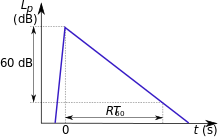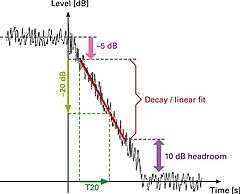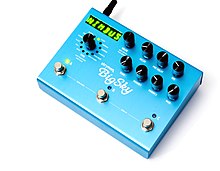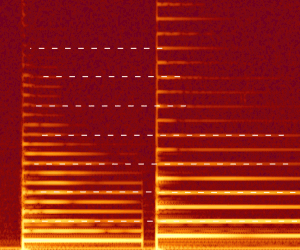Reverberation
Reverberation, in psychoacoustics and acoustics, is a persistence of sound after the sound is produced.[1] A reverberation, or reverb, is created when a sound or signal is reflected causing numerous reflections to build up and then decay as the sound is absorbed by the surfaces of objects in the space – which could include furniture, people, and air.[2] This is most noticeable when the sound source stops but the reflections continue, their amplitude decreasing, until zero is reached.
Reverberation is frequency dependent: the length of the decay, or reverberation time, receives special consideration in the architectural design of spaces which need to have specific reverberation times to achieve optimum performance for their intended activity.[3] In comparison to a distinct echo, that is detectable at a minimum of 50 to 100 ms after the previous sound, reverberation is the occurrence of reflections that arrive in a sequence of less than approximately 50 ms. As time passes, the amplitude of the reflections gradually reduces to non-noticeable levels. Reverberation is not limited to indoor spaces as it exists in forests and other outdoor environments where reflection exists.
Reverberation occurs naturally when a person sings, talks, or plays an instrument acoustically in a hall or performance space with sound-reflective surfaces.[4] The sound of reverberation is often electronically added to the vocals of singers and to musical instruments. This is done in both live sound systems and sound recordings by using effects units. Effects units that are specialized in the generation of the reverberation effect are commonly called reverbs.
Whereas reverberation normally adds to the naturalness of recorded sound by adding a sense of space, reverberation can reduce speech intelligibility, especially when noise is also present. Users of hearing aids frequently report difficulty in understanding speech in reverberant, noisy situations. Reverberation is a very significant source of mistakes in automatic speech recognition. Dereverberation is the process of reducing the level of reverberation in a sound or signal.
Reverberation time

Reverberation time is a measure of the time required for the sound to "fade away" in an enclosed area after the source of the sound has stopped.
When it comes to accurately measuring reverberation time with a meter, the term T60 [5] (an abbreviation for Reverberation Time 60dB) is used. T60 provides an objective reverberation time measurement. It is defined as the time it takes for the sound pressure level to reduce by 60 dB, measured after the generated test signal is abruptly ended.
Reverberation time is frequently stated as a single value if measured as a wideband signal (20 Hz to 20 kHz). However, being frequency dependent, it can be more precisely described in terms of frequency bands (one octave, 1/3 octave, 1/6 octave, etc.). Being frequency dependent, the reverberation time measured in narrow bands will differ depending on the frequency band being measured. For precision, it is important to know what ranges of frequencies are being described by a reverberation time measurement.
In the late 19th century, Wallace Clement Sabine started experiments at Harvard University to investigate the impact of absorption on the reverberation time. Using a portable wind chest and organ pipes as a sound source, a stopwatch and his ears, he measured the time from interruption of the source to inaudibility (a difference of roughly 60 dB). He found that the reverberation time is proportional to room dimensions and inversely proportional to the amount of absorption present.
The optimum reverberation time for a space in which music is played depends on the type of music that is to be played in the space. Rooms used for speech typically need a shorter reverberation time so that speech can be understood more clearly. If the reflected sound from one syllable is still heard when the next syllable is spoken, it may be difficult to understand what was said.[6] "Cat", "Cab", and "Cap" may all sound very similar. If on the other hand the reverberation time is too short, tonal balance and loudness may suffer. Reverberation effects are often used in studios to add depth to sounds. Reverberation changes the perceived spectral structure of a sound but does not alter the pitch.
Basic factors that affect a room's reverberation time include the size and shape of the enclosure as well as the materials used in the construction of the room. Every object placed within the enclosure can also affect this reverberation time, including people and their belongings.
Measurement of reverberation time

Historically, reverberation time could only be measured using a level recorder (a plotting device which graphs the noise level against time on a ribbon of moving paper). A loud noise is produced, and as the sound dies away the trace on the level recorder will show a distinct slope. Analysis of this slope reveals the measured reverberation time. Some modern digital sound level meters can carry out this analysis automatically.[7]
Several methods exist for measuring reverb time. An impulse can be measured by creating a sufficiently loud noise (which must have a defined cut-off point). Impulse noise sources such as a blank pistol shot or balloon burst may be used to measure the impulse response of a room.
Alternatively, a random noise signal such as pink noise or white noise may be generated through a loudspeaker, and then turned off. This is known as the interrupted method, and the measured result is known as the interrupted response.
A two-port measurement system can also be used to measure noise introduced into a space and compare it to what is subsequently measured in the space. Consider sound reproduced by a loudspeaker into a room. A recording of the sound in the room can be made and compared to what was sent to the loudspeaker. The two signals can be compared mathematically. This two port measurement system utilizes a Fourier transform to mathematically derive the impulse response of the room. From the impulse response, the reverberation time can be calculated. Using a two-port system allows reverberation time to be measured with signals other than loud impulses. Music or recordings of other sounds can be used. This allows measurements to be taken in a room after the audience is present.
Under some restrictions, even simple sound sources like handclaps can be used for measurement of reverberation [8]
Reverberation time is usually stated as a decay time and is measured in seconds. There may or may not be any statement of the frequency band used in the measurement. Decay time is the time it takes the signal to diminish 60 dB below the original sound. It is often difficult to inject enough sound into the room to measure a decay of 60 dB, particularly at lower frequencies. If the decay is linear, it is sufficient to measure a drop of 20 dB and multiply the time by 3, or a drop of 30 dB and multiply the time by 2. These are the so-called T20 and T30 measurement methods.
The RT60 reverberation time measurement is defined in the ISO 3382-1 standard for performance spaces, the ISO 3382-2 standard for ordinary rooms, and the ISO 3382-3 for open-plan offices, as well as the ASTM E2235 standard.
The concept of Reverberation Time implicitly supposes that the decay rate of the sound is exponential, so that the sound level diminishes regularly, at a rate of so many dB per second. It is not often the case in real rooms, depending on the disposition of reflective, dispersive and absorbing surfaces. Moreover, successive measurement of the sound level often yields very different results, as differences in phase in the exciting sound build up in notably different sound waves. In 1965, Manfred R. Schroeder published "A new method of Measuring Reverberation Time" in the Journal of the Acoustical Society of America. He proposed to measure, not the power of the sound, but the energy, by integrating it. This made it possible to show the variation in the rate of decay and to free acousticians from the necessity of averaging many measurements.
Sabine equation
Sabine's reverberation equation was developed in the late 1890s in an empirical fashion. He established a relationship between the T60 of a room, its volume, and its total absorption (in sabins). This is given by the equation:
- .
where c20 is the speed of sound in the room (at 20 °C), V is the volume of the room in m3, S total surface area of room in m2, a is the average absorption coefficient of room surfaces, and the product Sa is the total absorption in sabins.
The total absorption in sabins (and hence reverberation time) generally changes depending on frequency (which is defined by the acoustic properties of the space). The equation does not take into account room shape or losses from the sound traveling through the air (important in larger spaces). Most rooms absorb less sound energy in the lower frequency ranges resulting in longer reverb times at lower frequencies.
Sabine concluded that the reverberation time depends upon the reflectivity of sound from various surfaces available inside the hall. If the reflection is coherent, the reverberation time of the hall will be longer; the sound will take more time to die out.
The reverberation time RT60 and the volume V of the room have great influence on the critical distance dc (conditional equation):
where critical distance is measured in meters, volume is measured in m³, and reverberation time RT60 is measured in seconds.
Absorption coefficient
The absorption coefficient of a material is a number between 0 and 1 which indicates the proportion of sound which is absorbed by the surface compared to the proportion which is reflected back to the room. A large, fully open window would offer no reflection as any sound reaching it would pass straight out and no sound would be reflected. This would have an absorption coefficient of 1. Conversely, a thick, smooth painted concrete ceiling would be the acoustic equivalent of a mirror and have an absorption coefficient very close to 0.
Reverberation in music composition and performance
Several composers employ the reverberation effect as a main sound resource, having a comparable relevance as the solo instrument. For example, Pauline Oliveros[9], Henrique Machado[10] and many others. In order to employ the reverberant properties of the room, the composers are supposed to investigate and probe the sound response of that particular ambient, that will affect and inspire the creation of the musical work.
Creating reverberation effects
A performer or a producer of live or recorded music often induces reverberation in a work. Several systems have been developed to produce or to simulate reverberation.
Chamber reverberators
The first reverb effects created for recordings used a real physical space as a natural echo chamber. A loudspeaker would play the sound, and then a microphone would pick it up again, including the effects of reverb. Although this is still a common technique, it requires a dedicated soundproofed room, and varying the reverb time is difficult.
Plate reverberators
A plate reverb system uses an electromechanical transducer, similar to the driver in a loudspeaker, to create vibrations in a large plate of sheet metal. The plate’s motion is picked up by one or more contact microphones whose output is an audio signal which may be added to the original "dry" signal. In the late 1950s, Elektro-Mess-Technik (EMT) introduced the EMT 140.[11] Popular in recording studios, this system contributed to many hit records such as Beatles and Pink Floyd albums recorded at Abbey Road Studios in the 1960s, and others recorded by Bill Porter in Nashville's RCA Studio B. Early units had one pickup for mono output, and later models featured two pickups for stereo use. The reverb time can be adjusted by a damping pad, made from framed acoustic tiles. The closer the damping pad, the shorter the reverb time. However, the pad never touches the plate. Some units also featured a remote control. The EMT 140 weighs 400 pounds (180 kg), 600 pounds (270 kg) in manufacturers shipping crate.
Spring reverberators


A spring reverb system uses a transducer at one end of a spring and a pickup at the other, similar to those used in plate reverbs, to create and capture vibrations within a metal spring. Laurens Hammond was granted a patent on a spring-based mechanical reverberation system in 1939.[12] The Hammond Organ included a built-in spring reverberator.
Spring reverberators were once widely used in semi-professional recording and are frequently incorporated into Guitar amplifiers due to their modest cost and small size. One advantage over more sophisticated alternatives is that they lend themselves to the creation of special effects; for example rocking them back and forth creates a thundering, crashing sound caused by the springs colliding with each other.
Digital reverberators

Digital reverberators use various signal processing algorithms in order to create the reverb effect. Since reverberation is essentially caused by a very large number of echoes, simple reverberation algorithms use several feedback delay circuits to create a large, decaying series of echoes. More advanced digital reverb generators can simulate the time and frequency domain response of a specific room (using room dimensions, absorption, and other properties). In a music hall, the direct sound always arrives at the listener's ear first because it follows the shortest path. Shortly after the direct sound, the reverberant sound arrives. The time between the two is called the "pre-delay."
Reverberation, or informally, "reverb" or "verb", is one of the most universally used audio effects and is often found in guitar pedals, synthesizers, effects units, digital audio workstations (DAWs) and VST plug-ins.
Convolution reverb
Convolution reverb is a process used for digitally simulating reverberation. It uses the mathematical convolution operation, a pre-recorded audio sample of the impulse response of the space being modeled, and the sound to be echoed, to produce the effect. The impulse-response recording is first stored in a digital signal-processing system. This is then convolved with the incoming audio signal to be processed.
See also
References
- Valente, Michael; Holly Hosford-Dunn; Ross J. Roeser (2008). Audiology. Thieme. pp. 425–426. ISBN 978-1-58890-520-8.
- Lloyd, Llewelyn Southworth (1970). Music and Sound. Ayer Publishing. pp. 169. ISBN 978-0-8369-5188-2.
- Roth, Leland M. (2007). Understanding Architecture. Westview Press. pp. 104–105. ISBN 978-0-8133-9045-1.
- Davis, Gary (1987). The sound reinforcement handbook (2nd ed.). Milwaukee, WI: Hal Leonard. p. 259. ISBN 9780881889000. Retrieved February 12, 2016.
- "Reverberation Time RT60 Measurement". www.nti-audio.com.
- "So why does reverberation affect speech intelligibility?". MC Squared System Design Group, Inc. Retrieved 2008-12-04.
- "Reverberation Time RT60 Measurement". www.nti-audio.com.
- Papadakis, Nikolaos M.; Stavroulakis, Georgios E. "Handclap for Acoustic Measurements: Optimal Application and Limitations". Acoustics. Volume 2 (2): 224-245. Retrieved 30 June 2020.
- Oliveros, Pauline (2019-07-23). "Pauline Oliveros". Pauline Oliveros.
- Machado, Henrique. O Lado Oculto da Lua, composition for solo contrabassoon and reverbarating chamber, 2019
- Eargle, John M. (2005). Handbook of Recording Engineering (4 ed.). Birkhäuser. p. 233. ISBN 0-387-28470-2.
- Laurens Hammond, Electrical Musical Instrument, U.S. Patent 2,230,836, granted Feb. 4, 1941.
